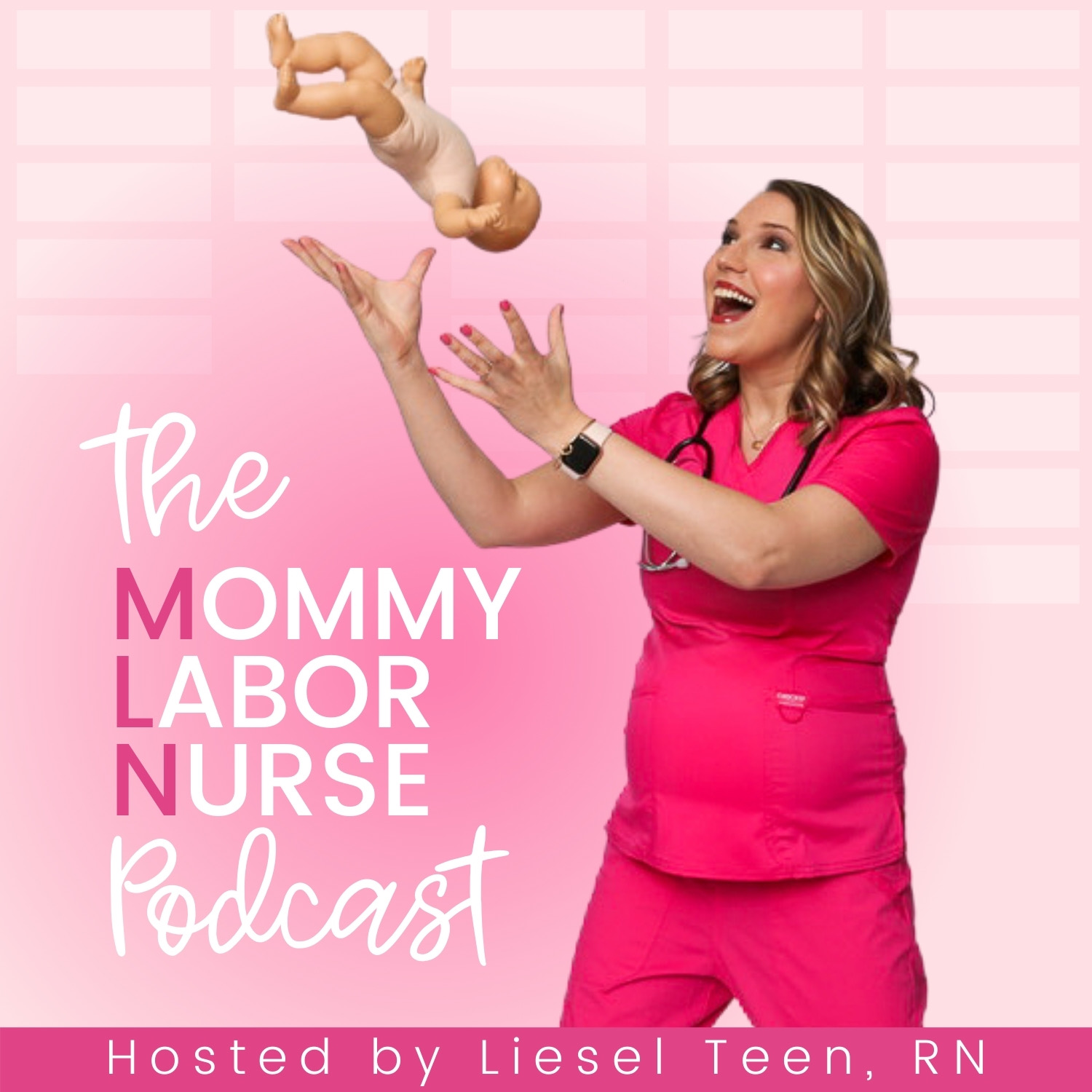This week on The Mommy Labor Nurse Podcast, I had the opportunity to chat with the lovely Dr. Natalie Crawford all about infertility and more specifically secondary infertility.
Dr. Crawford is a board-certified OBGYN and Reproductive Endocrinologist. She has a large social media following on Instagram, YouTube, and TikTok where she shares amazing content related to all things fertility and women’s health, with a healthy dose of buzzworthy controversy thrown in.
Inside the episode, Dr. Crawford talks about how and why she become an REI, shares about her own struggles with infertility, and talks a lot about the way the landscape of infertility support, community, and connection has changed over the past 5-10 years.
You’ll hear us talk about some of the most common causes of secondary infertility, what it looks like when you go to a fertility doctor for the first time, and what to expect from that process. Dr. Crawford and I also discuss what can be done to address infertility, when and why certain treatment options are used, and a whole lot more.
So, whether you are personally navigating infertility, or have a loved one that is struggling to conceive, this episode will help you gain some insight and knowledge into the world of fertility through Dr. Crawford’s expert lens. Let’s dive right in!
Let’s talk about secondary infertility
When I was putting together my interview questions for Dr. Crawford, I thought that secondary infertility was a great place to start. Many of you in the audience are currently pregnant or have already had a baby.
Maybe you’re thinking about baby number two, or currently facing secondary infertility, so I figured it’d be great to have a specialist weigh in! Dr. Crawford shared that secondary infertility is definitely a thing, and about 25% of her patients have secondary infertility – which is when you’ve had a prior live birth with your current partner and now you’re having a hard time conceiving a second (or more!) child.
She talks about how women with secondary infertility are often caught off guard and don’t feel like they fit into the infertility communities out there. This is because they are often cast off as not being grateful for the child they already have. That fact can make the experience of secondary infertility extremely lonely!
Top causes of secondary infertility
While we’re talking about secondary infertility, Dr. Crawford broke down some of the top reasons for infertility and things to be aware of:
- Irregular or absent periods
- Birth complications that have left you infertile such as retained placenta, postpartum hemorrhage, uterine infection, or even C-sections
- Breastfeeding affecting your cycle and ovulation
- Endometriosis
- Normal decrease in both male or female fertility with age
- Male infertility based on their environment and/or lifestyle factors effecting sperm counts
When you tune in you’ll hear her discuss each of these topics a bit more to help you better understand how and why these situations and factors have such an impact.
Related Article: Tracking Ovulation and TTC Tips
What are visits with a fertility doctor like?
As our conversation progresses, I thought it would be interesting to hear what it’s like to work with a fertility doctor. Again, we focused more on secondary infertility here, but most of it rings true for primary infertility as well.
Right away Dr. Crawford tells us that working with a fertility doctor is very different than a visit with your OBGYN. First visits are usually an hour long and involve a serious deep dive into your history. Your fertility doctor will ask lots of questions and really try to get into the nitty-gritty to find clues as to what might be going on.
After that initial appointment, there will be diagnostic evaluation and testing that’s followed up with an appointment where you and your doctor will make a plan of what to do next.
Some of the diagnostic evaluations you’ll hear Dr. Crawford discuss are:
- Semen analysis of the male partner
- A look into your ovarian reserve and what that means for fertility over time
- Checking your uterus and fallopian tubes for anatomical factors that might impact fertility
- Scouting for other issues related to irregular periods such as thyroid disease, pituitary abnormalities, diabetes, etc.
All of this takes about a month to complete and then you’ll work through the next steps.
Some common options for addressing infertility
At this point, I asked Dr. Crawford to review some of the options out there for women facing infertility and when she would recommend different treatment paths. She starts off her answer like this,
“We have limited tools in our tool belt and I think a lot of patients are surprised. They think we have some magic fairy dust that we can just get everybody pregnant. I say that all the time!
Like if I had the magic dust, we would sprinkle it and 100% of people would get pregnant super easy. But the reality is there are only a handful of things we can do. So it’s pretty easy to go through what they are and when are they indicated.”
Here are the things that a fertility doctor CAN do to help:
- Ovulation induction: These are medications we can give you to help you ovulate. This is recommended when your periods are not regular, or are regularly irregular. Basically they send a signal to your brain to amplify hormone production related to ovulation each month
- Intrauterine insemination (IUI): This is where your doctor will take the sperm on the day you’re ovulating, place it in a catheter, and then insert the sperm into the uterus. Dr. Crawford’s analogy here is that you’re taking your best players and putting them further down the field. If they can’t make the shot, they still won’t make the shot. This is indicated for couples with mild semen abnormalities, and best for normal fallopian tubes and uterus
- In vitro fertilization (IVF): For IVF, your eggs are fertilized with sperm inside a lab. They are watched and then the embryos are transferred right away, or frozen for a subsequent cycle. This is used when there are anatomical factors like blocked fallopian tubes, significant sperm issues, and sometimes in cases of unexplained infertility as well
When you listen in, you’ll hear Dr. Crawford dive more into the ins and outs of each of these. She gives an in-depth overview of what’s considered a severe vs. mild sperm abnormality and gets into success rates of IVF as it relates to age and other important factors.
Unexplained infertility
“This happens to patients with secondary infertility, and in general happens about 30% of the time with all the patients we see. And it’s really frustrating. And it’s worth noting, this means you go through that whole litany of diagnostic tests, and it’s all normal – sperm is fine, you’re ovulating, your tubes are open, your uterus is normal.
And I sit across from you, I don’t have the reason, which is really hard because humans love knowing what the problem is, because then we can say, “Great, how do we go and fix it?” and unexplained infertility leaves you in a middle zone.”
When someone comes to me as a patient and has unexplained infertility, we have two courses we take: a combination of Clomid and IUI because it doubles your chances of getting pregnant, or we do IVF.
Related Listening: Liesel Interviews an NP About Women’s Health: PCOS, Fertility, Endometriosis and More!
Wrapping up the episode
At the end of the episode, I ask Dr. Crawford if she can share some words of advice with our listeners as both a fertility doctor and specialist and as a woman who struggled with infertility herself.
First, she says to seek out online communities:
“The world is not what it is back when I had infertility and I think that’s a good thing. Yeah. So you can find information and resources and support and I encourage you to do so. Seek out the infertility community, whether it’s in Facebook groups or on Instagram”
Second, she says to use fertility doctors online to help you prepare for your first appointment and erase the fear and unknown:
“Fertility doctors of Instagram are working really, really hard to create content, to help you not be scared going into that first visit, and to help you have the resources that you need. And so whether it’s some of my resources, or colleagues of mine, you can find board certified REIs who are giving you facts about what to expect, questions to ask, and basics about infertility one on one”
And third, she says,
“Fertility doctors are really nice, we care about you. We’re not scary. We really are passionate about this subject matter and passionate about this patient population. So don’t be afraid of us.”
And finally,
“If you go to a visit with a fertility doctor and or a clinic, and it’s not meshing, it’s not the right relationship. This is a very personal aspect of health care. And it is completely fine to leave and seek out somewhere that is going to better fit your needs. Do not feel trapped with a clinic!”
About Dr. Natalie Crawford

Dr. Natalie Crawford is board certified in both Obstetrics and Gynecology and Reproductive Endocrinology and Infertility and is Director of Patient Experience and Education and co-founder of Fora Fertility, a boutique fertility practice in Austin, Texas.
Dr. Crawford values developing close connections with her patients throughout their fertility journeys. She is passionate about education and promotes fertility awareness through social media and community outreach.
Connect with Dr. Crawford:
- Website: https://www.nataliecrawfordmd.com/
- Instagram: @nataliecrawfordmd
- YouTube: Natalie Crawford, MD
- TikTok: @nataliecrawfordmd
- Twitter: @ncrawfordmd
- Podcast: As a Woman





